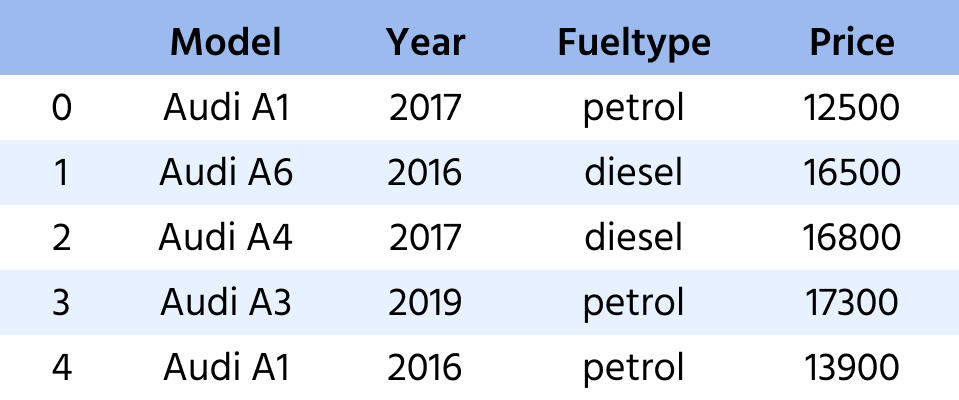 Challenge: Using iloc[]
Challenge: Using iloc[]
The DataFrame you are working with:
You can also use negative indexing to access rows in the DataFrame. Negative indexing starts from the end of the DataFrame: index -1 points to the last row, -2 to the second to last, and so on.
To access the seventh row (which refers to Latvia), you can use either index 6 or -1.
123456import pandas countries_data = {'country' : ['Thailand', 'Philippines', 'Monaco', 'Malta', 'Sweden', 'Paraguay', 'Latvia'], 'continent' : ['Asia', 'Asia', 'Europe', 'Europe', 'Europe', 'South America', 'Europe'], 'capital':['Bangkok', 'Manila', 'Monaco', 'Valletta', 'Stockholm', 'Asuncion', 'Riga']} countries = pandas.DataFrame(countries_data) # Accessing to the seventh row using negative indexing print(countries.iloc[-1])
Running the above code will return the row highlighted in the image below:
Swipe to start coding
You are given a DataFrame named audi_cars.

- Select the entire row (all columns) for the
'Audi A1'model from the year 2017 and store it inaudi_A1_2017. - Do the same for the
'Audi A1'model from the year 2016 and store it inaudi_A1_2016. - Finally, select the
'Audi A3'model and store it inaudi_A3.
Solution
Thanks for your feedback!
single
Ask AI
Ask AI

Ask anything or try one of the suggested questions to begin our chat
Can you explain how negative indexing works with columns?
What happens if I use an index that is out of range?
Can I use negative indexing to select multiple rows at once?

Awesome!
Completion rate improved to 3.03 Challenge: Using iloc[]
Challenge: Using iloc[]
Swipe to show menu
The DataFrame you are working with:
You can also use negative indexing to access rows in the DataFrame. Negative indexing starts from the end of the DataFrame: index -1 points to the last row, -2 to the second to last, and so on.
To access the seventh row (which refers to Latvia), you can use either index 6 or -1.
123456import pandas countries_data = {'country' : ['Thailand', 'Philippines', 'Monaco', 'Malta', 'Sweden', 'Paraguay', 'Latvia'], 'continent' : ['Asia', 'Asia', 'Europe', 'Europe', 'Europe', 'South America', 'Europe'], 'capital':['Bangkok', 'Manila', 'Monaco', 'Valletta', 'Stockholm', 'Asuncion', 'Riga']} countries = pandas.DataFrame(countries_data) # Accessing to the seventh row using negative indexing print(countries.iloc[-1])
Running the above code will return the row highlighted in the image below:
Swipe to start coding
You are given a DataFrame named audi_cars.

- Select the entire row (all columns) for the
'Audi A1'model from the year 2017 and store it inaudi_A1_2017. - Do the same for the
'Audi A1'model from the year 2016 and store it inaudi_A1_2016. - Finally, select the
'Audi A3'model and store it inaudi_A3.
Solution
Thanks for your feedback!
single